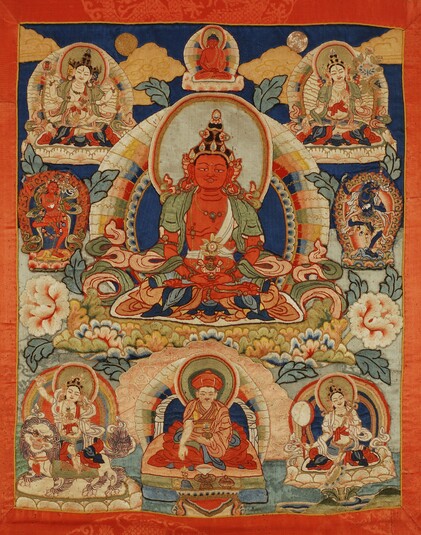
Item: Amitayus Buddha - Amitayus
| Origin Location | Bhutan |
|---|---|
| Date Range | 1900 - 1959 |
| Lineages | Drukpa (Kagyu, Bhutan) and Buddhist |
| Material | Ground: Textile Image, Embroidery, Applique |
| Collection | Rubin Museum of Art |
Alternate Names: Aparimitayurjñana
Classification: Deity
Appearance: Buddha
Gender: Male
Amitayus, Buddha (Tibetan: tse pag me. English: the Enlightened One of Immesurable Life) Lord of Limitless Life and Pristine Awareness, in the Sambogakaya aspect (Enjoyment Body) of a Buddha. Also see the Bhutan Main Page).
Amitayus Tibetan: Tse pag me
Tibetan: Tse pag me
Amitayus Buddha is depicted in the center of the composition. Above that is Amitabha Buddha with Ushnishavijaya on the viewers left and White Tara on the right. These three deities together are known as the Three Long-life Deities of Tibetan Tantric Buddhism. At the middle right and left are red Vajravarahi and the blue Lion-faced Simhamukha. These two are female meditational deities of the highest Yoga Tantras and are associated with Chakrasamvara. At the bottom center is a teacher of the Drugpa Kagyu Tradition wearing the easily recognized Drugpa religious hat. At the bottom left is the Himalayan mountain goddess Tseringma and on the right the Tibetan goddess Dorje Yudronma.
"Bhagavan Lord of Limitless Life and Primordial Wisdom with a body red in colour, one face, two hands and with two long eyes glancing with compassion on beings, gazing on the entirety of migrators; and a smiling face, wearing the complete sambhogakaya vestments. Above the two hands held in meditation is a long-life vase filled with the nectar of immortality; with the hair in tufts, adorned with silks and jewels, seated in vajra posture, the body blazing with the shining light of the [32] marks and [80] examples." (Sakya Trizin Kunga Tashi, 1656-1711).
Common to all traditions of Himalayan (Bhutanese) and Tibetan Buddhism, Amitayus primarily belongs to the three lower Tantra classifications. In the Nyingma tradition, he has both 'Kama' (Oral) and 'Terma' (Treasure) lineages of practice.
In the Mahayana Tradition of Buddhism a buddha is described as having three bodies: a form body (nirmanakaya), apparition body (sambhogakaya) and an ultimate truth body (dharmakaya). The ultimate truth body is without form and description.
Jeff Watt 5-2008
Front of Painting
English Translation of Inscription: [no inscriptions]
Reverse of Painting
English Translation of Inscription: [the back is covered by the cloth mount]
Textile: Appliqué Masterworks
Buddhist Deity: Amitayus Buddha (Aparimitāyurjñāna, 无量寿佛, སངས་རྒྱས་ཚེ་དཔག་མེད།)
Collection of Rubin Museum of Art: Textile Page
Textile: Applique Artwork Main Page
Textile: Embroidered Artwork Main Page
Collection of Rubin Museum of Art: Bhutan
Region: Bhutan, Textiles
Buddhist Deity: Amitayus Buddha (Textile)
Subject: Drums in Art Main Page
Region: Bhutan: Painting & Textile Masterworks
Collection of RMA: Textile Masterworks
Collection of RMA: Bhutan Masterworks
Textile: Main Page
Buddhist Deity: Amitayus Buddha, 无量寿佛, སངས་རྒྱས་ཚེ་དཔག་མེད། (Masterworks)



